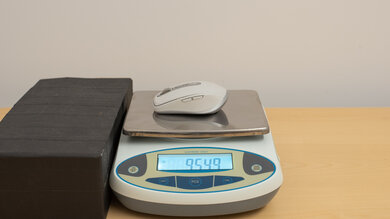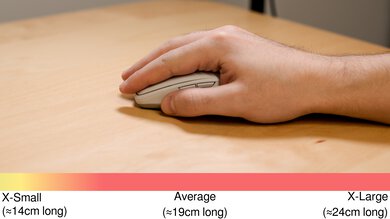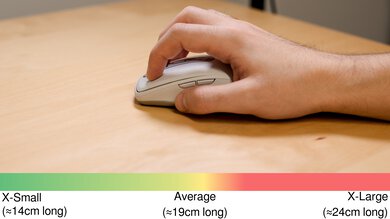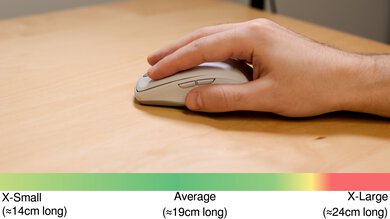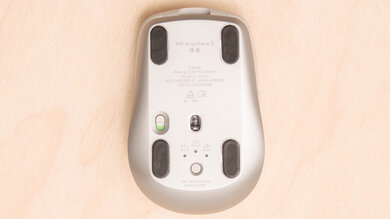The Logitech MX Anywhere 3 is a good office mouse designed to be used on-the-go. Its small and compact design makes it easy to carry around with you, but there's no slot to store its USB receiver, which is quite disappointing. It's well-built and you shouldn't have to worry about breaking it by tossing it into your bag. It connects to any device via Bluetooth or its proprietary receiver, and it works on both Windows and macOS. It's comfortable and works best for those using the fingertip grip, as it may be too small for the claw or palm grip. You can reprogram some of its buttons, and even though it doesn't have a side wheel, it still has a horizontal scrolling feature with its scroll wheel.
Our Verdict
The Logitech MX Anywhere 3 is very good for office use. Despite its small size, it's comfortable and a good choice for those using the fingertip grip. It's well-built, and you can reprogram a few buttons. It connects to your device either through Bluetooth or its proprietary receiver.
-
Comfortable for those using the fingertip grip.
-
Connects to any device via Bluetooth or its receiver.
-
Scroll wheel can be unlocked for infinite scrolling.
-
Too small for most hand sizes using palm or claw grips.
-
Limited number of programmable buttons.
-
No slot to store USB receiver.
The Logitech MX Anywhere 3 is good for FPS video games. Although not designed as a gaming mouse, it's light, and the feet provide a decent gliding experience. However, it's small and only suggested for those using the fingertip grip, and it has a low polling rate. Also, its click latency is too high for reaction-based or fast-paced games.
-
Okay gliding experience.
-
Light and compact design.
-
Fixed 125Hz polling rate.
-
Stiff cable.
-
No slot to store USB receiver.
The Logitech MX Anywhere 3 is only okay for MMO gaming. It's not designed for it and only has two side buttons, which may not be enough for most MMO gamers. Still, you can adjust the CPI in small steps, and it has a low minimum CPI. Unfortunately, the polling rate is low and can't be changed, and its click latency is too high for anything but casual gaming.
-
Comfortable for those using the fingertip grip.
-
Okay gliding experience.
-
Fixed 125Hz polling rate.
-
Only two side buttons.
-
No slot to store USB receiver.
-
No slot to store USB receiver.
- 8.0 Work
- 7.2 Video Games (FPS)
- 6.8 Video Games (MMO)
- 6.5 Raw Performance
- Updated Jan 05, 2024: We've updated the CPI graph displayed in the Sensor Latency section of this review. Our results remain the same, but these graphs have two new columns with results from the Delay At Half Movement and Delay To End Of Movement tests.
- Updated Dec 01, 2023: We've converted this review to Test Bench 1.5. This update adds a new Main Button test group, which provides button actuation data and switch information. We've also made minor changes to how we calculate the Office usage score. For more details, you can see our full changelog here.
- Updated Jul 14, 2023: We've added a link to the newly-reviewed Logitech M240 in this review's Additional Buttons section.
- Updated Jun 30, 2023: We've corrected an error in the Additional Buttons section of this review. The result of the Total Number of Buttons test has been changed from 6 to 7, as the previous result failed to account for a physical button on the mouse's underside.
- Updated Feb 24, 2023: We've converted this review to Test Bench 1.4. This update modifies our Hand Size Recommendation test, adding a more granular hand size recommendation chart. We've moved several minor tests into different test groups, removed the Travel usage, and added a new Raw Performance usage. For more details, you can see our full changelog here.
- Updated Sep 08, 2022: We've converted this review to Test Bench 1.3. This update adds a new Sensor Latency test and makes minor changes to several of our existing tests, resulting in test result changes in several sections. For more information, you can check out our full changelog here.
- Updated Aug 15, 2022: We've converted this review to Test Bench 1.2. This update simplifies our Weight test and expands on our CPI test from Test Bench 1.1, resulting in changes to test results in both sections. For more details, you can see our complete changelog here.
- Updated Jun 13, 2022: We've updated this review to Test Bench 1.1, which revamped our click latency test methodology. We've updated the text to reflect our new results in various sections, including the Click Latency test box, Usages, Introduction, and other locations where we discuss click latency.
- Updated May 30, 2022: We've converted this review to Test Bench 1.1. This update revamps our Click Latency test and results in changes to test results. For more details, you can see our full changelog here.
- Updated Dec 04, 2020: Review published.
- Updated Dec 01, 2020: Early access published.
- Updated Nov 27, 2020: Our testers have started testing this product.
- Updated Nov 26, 2020: The product has arrived in our lab, and our testers will start evaluating it soon.
- Updated Nov 23, 2020: We've purchased the product and are waiting for it to arrive in our lab.
Differences Between Sizes And Variants
We tested the Logitech MX Anywhere 3 in pale grey, but it's also available in graphite and rose. Logitech also sells a Logitech MX Anywhere 3 for Mac variant, and there are a few differences, which you can see listed below.
| Model | Colors | Cable | USB Receiver |
| MX Anywhere 3 | Graphite, Pale Grey, Rose | USB-C to USB-A | Yes |
| MX Anywhere 3 for Mac | Pale Grey | USB-C to USB-C | No |
If you come across a Logitech MX Anywhere 3 that's different from ours, let us know and we'll update the review. You can see the label for our unit here.
Compared To Other Mice
The Logitech MX Anywhere 3 is a good travel mouse and is similar to the Logitech MX Anywhere 2S. It provides good performance for what it's intended for, but it's on the costly side, and its small size isn't ideal for those using the palm or claw grip. The Razer Atheris is similar in terms of performance and costs much less. Also see our recommendations for the best ergonomic mice, the best wireless mice, and the best Logitech mice.
The Logitech MX Anywhere 3 and the Logitech Signature M650 are both wireless mice designed for office use; however, the MX Anywhere 3 performs better overall. The MX Anywhere 3 has a free-scrolling mode you can toggle between using a button behind the scroll wheel, and it connects with multiple devices at once. On the other hand, the Signature M650 is better-suited if you use a palm or claw style grip with small or medium-sized hands. Also, it has a storage compartment for its USB receiver, so you won't lose it while bringing the mouse around.
The Logitech MX Anywhere 3 and the Logitech MX Anywhere 3S are similar compact wireless mice in the same product lineup. The MX Anywhere 3 is the older version and connects via Bluetooth or Logitech's Unifying Receiver. The MX Anywhere 3S is newer and has quieter left- and right-click buttons and an improved sensor with a higher maximum CPI. It connects via Bluetooth or Logitech's BOLT receiver, which is sold separately.
The Logitech MX Master 3S and the Logitech MX Anywhere 3 are work mice that share several features. You can wirelessly pair either mouse with up to three devices at once, and they both have scroll wheels with free-scrolling modes. That said, the MX Master 3S includes several features the Anywhere 3 lacks, including quieter clicks, gesture controls, an improved sensor, and a secondary scroll wheel. On the other hand, the Anywhere 3 is much more compact and designed with travel use in mind, while the MX Master 3S is larger and fairly bulky, so it's best suited for desktop use.
The Logitech Lift and the Logitech MX Anywhere 3 are both wireless productivity mice well-suited for small and medium-sized hands, but they have several differences. The Lift is a vertical mouse that you hold in a "handshake" position. It uses a single AA battery for power. The click buttons are also significantly quieter. On the other hand, the MX Anywhere 3 has a more symmetrical design and recharges with a USB-C cable. Both mice have scroll wheels with a free-scrolling function, but it automatically engages when you flick the mouse wheel quickly on the Lift, and you can toggle it manually on the MX Anywhere 3.
The Logitech MX Anywhere 3 is better overall than the Apple Magic Mouse 2. The Logitech feels more comfortable overall, has programmable buttons, and the scroll wheel unlocks for infinite scrolling. It also has lower click latency and a customizable CPI range. However, the Apple feels better built and is easier to carry around because it doesn't have a USB receiver.
The Logitech MX Anywhere 3 is better for the most part than the Logitech MX Anywhere 2S. The 3 feels better-built, it's lighter, and it has lower click latency. However, the 2S has more programmable inputs because the scroll wheel has left/right tilt inputs.
The Logitech MX Anywhere 3 and the Razer Pro Click Mini are very similar performing mice designed for travel and productivity uses. The Razer has more programmable inputs, a higher max polling rate, better feet, and L/R tilts on the scroll wheel. It also has a storage compartment for the USB receiver, which the Logitech lacks. On the other hand, the Logitech has a rechargeable battery, and its sensor works on glass.
The Logitech MX Master 3 is a much better office mouse than the Logitech MX Anywhere 3. The Master 3 feels better-built, is much more comfortable, and has more programmable buttons. However, the Anywhere 3 is better for travel because it's smaller, much lighter, and has lower click latency.
The Logitech MX Master 2S and the Logitech MX Anywhere 3 are in the same family. The 2S is designed for the office, while the Anywhere is for traveling. The Master is twice as big and quite heavy. It has an ergonomic shape with a slight curve and a thumb rest for more comfort. It’s a great choice for a palm or a claw grip, though people with smaller hands may have difficulty using it with any grip style. On the contrary, the Anywhere is fairly small and lightweight, and it’s well-suited for a fingertip grip.
The Razer Pro Click is better overall than the Logitech MX Anywhere 3. The Razer is much more comfortable, is a better choice for a palm or claw grip, has a much wider CPI range, and has many more programmable buttons. However, the Logitech is lighter, much smaller, and you can unlock the scroll wheel for infinite scrolling.
The Logitech MX Anywhere 3 is a better office mouse than the Razer Atheris. It feels better-built and more comfortable, is lighter, and has lower click latency. However, the Razer is better for travel because it has a slot to store its USB receiver. It also has a wider CPI range, a higher polling rate, and many more programmable inputs.
The Logitech MX Anywhere 3 is a better mouse overall, but some may find the Logitech M535 a better travel mouse. The Anywhere 3 connects wirelessly with a USB receiver or via Bluetooth and has a rechargeable battery. It has two side buttons, a lower click latency, and you can unlock the wheel for free scrolling. It's suitable for most hand sizes using a fingertip grip. Comparatively, the M535 is more portable but connects via Bluetooth and uses one AA battery. It has gesture controls and a wheel with L/R tilt. It's suitable for smaller hands using a claw or fingertip grip.
The Logitech MX Anywhere 3 is better for most uses than the Dell Alienware AW610M. The Logitech is lighter, has Bluetooth support, has an extra programmable button, and you can unlock the scroll wheel for infinite scrolling. However, the Alienware has a slot to store its USB receiver, comes with a better, braided cable, and it feels more comfortable overall.
The Logitech Precision Pro is better than the Logitech MX Anywhere 3. The Precision Pro's higher back helps it feel more comfortable with a palm grip for small and medium hands, and it allows you to use it with a fingertip grip if you have large or extra-large hands. It also has an L/R wheel tilt feature. However, the Anywhere 3 is significantly lighter, and it has a rechargeable battery.
The Logitech MX Anywhere 3 and Logitech Marathon Mouse M705 are both very good office mice designed for slightly different uses. While the M705 has a more ergonomic and comfortable design suitable to a wider range of grip types, is a bit bulkier, can only connect wirelessly via its USB receiver, and is powered by two AA batteries. On the other hand, the MX Anywhere 3 is designed with travel in mind, so it's much lighter and smaller, making it easier to slip it into laptop bags, and it charges via USB-C. It also supports Bluetooth, allowing it to pair with most laptops without the need for a USB receiver, and its sensor works on glass. Both mice also have two programmable side buttons and scroll wheels that you can unlock for free scrolling.
The Logitech MX Anywhere 3 and the Logitech M317 are both small, wireless mice designed for travel use, but the MX Anywhere 3 performs better overall. The MX Anywhere 3 has two side buttons, a free-scrolling mode, and Bluetooth connectivity with up to three devices at once. The M317 lacks these features and also isn't as customizable.
Test Results
This mouse has an ambidextrous design and looks similar to its predecessor, the Logitech MX Anywhere 2S, but with a sleeker style. The 'Pale Grey' variant we tested has a matte white body with silver trim around the base and near the scroll wheel. The scroll wheel is chrome, and there's the Logitech logo underneath it. There's no RGB lighting anywhere on the mouse.
The Logitech MX Anywhere 3 is light and compact and should fit in most bags or laptop cases. However, there's no slot to place the USB receiver, which is disappointing if you need to carry the mouse around a lot. If you want a more portable wireless option that has a USB storage compartment, check out the Logitech Signature M650.
The build quality is great. It's made entirely out of solid plastic and feels well-built. There are rubber grips on the sides that feel good but aren't extremely grippy. The scroll wheel is metal and has grooves instead of a rubber grip like the Logitech MX Anywhere 2S. It wiggles from side to side even though it doesn't have left/right tilt options.
This mouse is lighter than the Logitech MX Anywhere 2S and isn't heavy to carry around. However, there's no weight optimization.
The Logitech MX Anywhere 3 is comfortable. It's small and only really useful for those using the fingertip grip. It has an ambidextrous design, but the side buttons are placed on the left side, so it's better suited for right-handed use. The buttons are well-placed, and the side grips feel good. If you'd prefer a more ergonomic, right-slanted shape, consider the Logitech Precision Pro or the Logitech Marathon Mouse M705.
It has incredible wireless options. You can connect to it either through its proprietary receiver or through Bluetooth. It can connect with up to three devices at once, but we don't test for this. You can use it while charging, but data isn't sent over the cable, and you still have to be connected wirelessly while it's charging. The battery is advertised to last up to 70 days on a full charge, but we don't test for this.
Note: There's a Logitech MX Anywhere 3 for Mac variant that doesn't come with a USB receiver and only connects through Bluetooth.
This mouse comes with an okay rubber cable. It's a bit short and feels stiff. It comes with a USB-C to USB-A cable, but the Logitech MX Anywhere 3 for Mac variant has a USB-C to USB-C cable instead.
The Logitech Anywhere 3 has an okay number of buttons. You can reprogram the side buttons, the scroll wheel's click, and the middle button below the scroll wheel. However, the scroll wheel doesn't have left/right tilt options. You can also set one of the buttons as gesture support, which gives you an extra set of four commands when you move the mouse in a certain direction. If you're interested in a much more basic wireless mouse that only has left- and right-click buttons and a scroll wheel, check out the Logitech M240.
The click latency is mediocre. It's best-suited for casual gaming, browsing, or productivity tasks, as it's too high for competitive or reaction-based games. Although its click latency is less consistent over a Bluetooth connection, you likely won't notice the inconsistency during use.
It has the same sensor as the Logitech MX Anywhere 2S. Its CPI range is narrow, but it should be fine for people using it for work, and you can adjust the sensitivity in small steps. The sensor stays consistent when moving at fast or slow speeds, and it also works on glass, which is rare. The polling rate is fixed at 125Hz.
The grooved metal scroll wheel feels smooth, and the steps are well-defined when in the notched mode. You can also enable a faster, free-scrolling mode by pressing the middle button below the scroll wheel. There's no side wheel, but you can use horizontal scrolling by pressing one of the side buttons and using the regular scroll wheel. If you're looking for a similar mouse with L/R wheel tilts, check out the Razer Pro Click Mini . Or, for a full-sized mouse for your desktop that has both a primary scroll wheel that unlocks for free-scrolling and a second scroll wheel on the side of the mouse dedicated to horizontal scrolling, check out the Logitech MX Master 3S.
The Logitech Anywhere 3 is loud, but it still shouldn't bother others around you unless you're in a very quiet environment.
The Logitech Options software has great customization options. It's available on both macOS and Windows, it's easy-to-use, and the interface is simple. You can customize the buttons for specific applications, and those settings are automatically used when you open that application.






